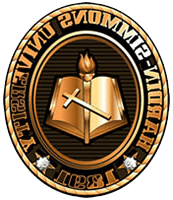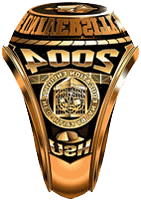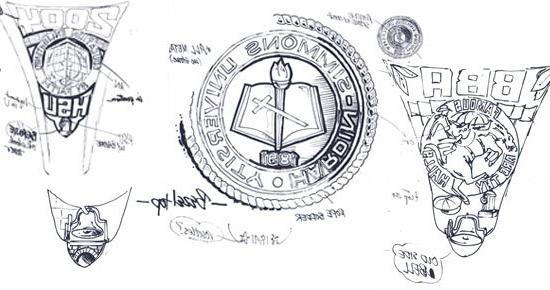 At the center of the Hardin-Simmons University experience, our Lord and Savior Jesus Christ reigns supreme. Through Him, we pursue excellence in our spiritual, emotional, and educational growth.
At the center of the Hardin-Simmons University experience, our Lord and Savior Jesus Christ reigns supreme. Through Him, we pursue excellence in our spiritual, emotional, and educational growth.
It’s fitting, then, that HSU’s Official Ring is made of refined gold, reminding the wearer of the purifying fire of academics, family, friends, and Jesus Christ. The Ring is crowned with the university’s official seal. The open book represents the Holy Bible and speaks of the pursuit of knowledge. The cross reminds us of the sacrificial death of Jesus Christ and the invitation to follow Him. The flame represents both the Holy Spirit and the quest, with His guidance, for excellence.
The stars on either side of the founding date, 1891, represent the pioneer Texas preachers, ranchers, and other leading citizens whose vision and sacrifices helped bring our school into existence. The stars also remind the wearer of all those who have kept and continue to keep the HSU legacy alive and ever-growing, often with great personal sacrifice.
The bezel is encircled by a lariat indicative of the school’s strong western heritage. The lariat forms an ever-encircling reminder of the faith in God which surrounds the wearer and the university. The Legacy shoulder of the ring is dominated by the bucking horse and rider. The Simmons College teams were named “Cowboys” in 1913 recognizing the school’s ranching legacy. The western tradition was reinforced in 1946 when HSU hosted the first collegiate rodeo in the United States.
 The words “Famous are thy halls” are taken from the Hardin-Simmons Anthem written in 1917. Though the school was little-known then, those words were prophetic, as through the years, HSU has indeed become famous through the accomplishments of her students, alumni, faculty, and staff, both on and off the campus. Above these words are six flags representing the flags of Texas, carried since the 1930s by HSU’s White Horse Riders, symbolizing the school’s Texas roots.
The words “Famous are thy halls” are taken from the Hardin-Simmons Anthem written in 1917. Though the school was little-known then, those words were prophetic, as through the years, HSU has indeed become famous through the accomplishments of her students, alumni, faculty, and staff, both on and off the campus. Above these words are six flags representing the flags of Texas, carried since the 1930s by HSU’s White Horse Riders, symbolizing the school’s Texas roots.
Degree letters are engraved at the top of this side, celebrating the accomplishments of the wearer. Positioned on either side of the wearer’s degree are branches of pecan leaves, reminding us of the shade-providing trees on campus, many of which were planted in 1910 by HSU’s then first lady, Mrs. J.D. Sandefer.
A field of bricks, reminiscent of the classical red brick architecture of the campus, is an appropriate background for HSU’s historic campus bell, now displayed near the Reflection Pond, which hung in the old Main building at the turn of the 20th century and served as the college time piece for over two decades.
The class year is engraved on the Heritage shoulder of the ring to recognize the wearer’s unique HSU experience. The Legett Memorial Bridge spans the Reflection Pond on the front green and was dedicated by the May 2002 senior class to the memory of Judge K. K. Legett, a founder of the university. The bridge represents the unity experienced on the HSU campus, just as the class ring is a symbol of the unity among all graduates past, current, and future. It also honors the unity experienced by the nation following the tragic events of September 11, 2001.
 The ring pictures the beautiful stained glass window of Logsdon Chapel, completed in 1989, which forms the backdrop for a variety of events, including many weddings. The cross represents Jesus Christ who died to redeem all people. The dove symbolizes the Holy Spirit, our Comforter. The Bible is God’s Word. And the concentric circles signify the spreading influence of HSU exes as they go out into the world both to share the Gospel and to exemplify Christian living in all walks of life.
The ring pictures the beautiful stained glass window of Logsdon Chapel, completed in 1989, which forms the backdrop for a variety of events, including many weddings. The cross represents Jesus Christ who died to redeem all people. The dove symbolizes the Holy Spirit, our Comforter. The Bible is God’s Word. And the concentric circles signify the spreading influence of HSU exes as they go out into the world both to share the Gospel and to exemplify Christian living in all walks of life.
Encircling the chapel window is the school motto, “An Education Enlightened by Faith.” Coined in the mid-1990s, the motto puts into words a goal held by the university since 1891.
Generations of students treasure their purple and gold HSU beanie, which first appeared in the 1930s. Although the tradition of having freshmen wear beanies during their first semester has varied through the years, for many it remains a treasured souvenir of student days.
Cleverly tucked in the letters “HSU” is a tribute to one of the school’s most loved icons, a white bulldog. One day, this beloved dog caused a cafeteria employee to trip and so obtained the name “Dam-It.” (He was called Fritz on Sundays.) When the dog died of pneumonia, his funeral captured international attention. Today, his resting place is near the reflecting pond marked by a purple and gold fire hydrant and a plaque reading, “Dam-It, he is dead. College Mascot, 1916-1920.”

 At the center of the Hardin-Simmons University experience, our Lord and Savior Jesus Christ reigns supreme. Through Him, we pursue excellence in our spiritual, emotional, and educational growth.
At the center of the Hardin-Simmons University experience, our Lord and Savior Jesus Christ reigns supreme. Through Him, we pursue excellence in our spiritual, emotional, and educational growth. The words “Famous are thy halls” are taken from the Hardin-Simmons Anthem written in 1917. Though the school was little-known then, those words were prophetic, as through the years, HSU has indeed become famous through the accomplishments of her students, alumni, faculty, and staff, both on and off the campus. Above these words are six flags representing the flags of Texas, carried since the 1930s by HSU’s White Horse Riders, symbolizing the school’s Texas roots.
The words “Famous are thy halls” are taken from the Hardin-Simmons Anthem written in 1917. Though the school was little-known then, those words were prophetic, as through the years, HSU has indeed become famous through the accomplishments of her students, alumni, faculty, and staff, both on and off the campus. Above these words are six flags representing the flags of Texas, carried since the 1930s by HSU’s White Horse Riders, symbolizing the school’s Texas roots. The ring pictures the beautiful stained glass window of Logsdon Chapel, completed in 1989, which forms the backdrop for a variety of events, including many weddings. The cross represents Jesus Christ who died to redeem all people. The dove symbolizes the Holy Spirit, our Comforter. The Bible is God’s Word. And the concentric circles signify the spreading influence of HSU exes as they go out into the world both to share the Gospel and to exemplify Christian living in all walks of life.
The ring pictures the beautiful stained glass window of Logsdon Chapel, completed in 1989, which forms the backdrop for a variety of events, including many weddings. The cross represents Jesus Christ who died to redeem all people. The dove symbolizes the Holy Spirit, our Comforter. The Bible is God’s Word. And the concentric circles signify the spreading influence of HSU exes as they go out into the world both to share the Gospel and to exemplify Christian living in all walks of life.